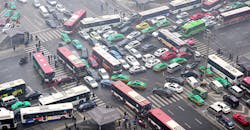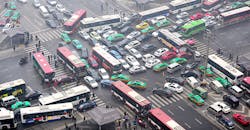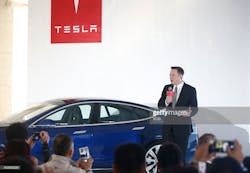Deadly Roads Give China a Grim Edge in Driverless Cars
Transport safety advances the same way physicist Max Planck saw science progressing: one funeral at a time.
That's bad news for the people of China, whose roads are some of the world's most dangerous. But it's an advantage for the slew of Chinese companies racing to overtake Silicon Valley and Detroit in developing self-driving vehicles.
The risks on the country's roads are notorious, including horrific activities such as drivers intentionally killing pedestrians after hitting them to avoid liability for a lifetime of medical bills.
There were an estimated 261,367 road deaths during 2013, according to the World Health Organization, equivalent to nearly eight years of fatalities at U.S. rates or 143 years in the U.K.
Adjusting for the number of vehicles on the road makes China look worse if anything.
(Photo by ChinaFotoPress/Getty Images)
In the U.S., 12.85 people died for every 100,000 vehicles during 2013, compared with 104 deaths for every 100,000 in China. Among major economies, only India has a higher fatality rate.
A paradoxical effect of that grim toll is that the hurdle to building a safer self-driving car in China is much lower than in the U.S.
As Gadfly wrote Tuesday, regulation is becoming as significant a barrier to developing autonomous vehicles in the U.S. as the technical challenges.
As a democracy, the country offers plenty of opportunities at the state and federal level for politicians to throw up roadblocks to new technologies.
"One small defect could lead to a massive safety crisis," Bill Nelson, the top Democrat on the U.S. Senate's commerce committee, told a hearing into driverless cars last month. "We must ask difficult policy questions and have frank discussions on what can go wrong and what can be done to prevent it."
The pressure to do that is only going to increase if self-driving cars start killing people, as they inevitably will.
Transport technologies go through a fairly well-understood learning curve. Accident numbers surge in the early years as adoption grows rapidly, then tail off as real-world experiences give engineers a better idea of what can go wrong. It took six decades of commercial aviation before peacetime fatalities reached their peak in 1972.
Rail transport showed a similar pattern, with the highest number of accidents occurring in the U.K. during the 1870s, four decades after the Liverpool and Manchester Railway kick-started the modern railway era.
A similar pattern shows up even in the more safety-critical, modern technology of robotic surgery, according to a study this month by researchers led by Homa Alemzadeh of the University of Illinois at Urbana-Champaign .
After 14 years of use, robot surgeons perform a bit better than humans in gynecology, but results have been more mixed in urology and somewhat worse in many specialized procedures, according to the analysis.
BEIJING, CHINA - OCTOBER 23: (CHINA OUT) Elon Musk, Chairman, CEO and Product Architect of Tesla Motors, addresses a press conference to declare that the Tesla Motors releases v7.0 System in China on a limited basis for its Model S, which will enable self-driving features such as Autosteer for a select group of beta testers on October 23, 2015 in Beijing, China. The v7.0 system includes Autosteer, a new Autopilot feature. While it's not absolutely self-driving and the driver still need to hold the steering wheel and be mindful of road conditions and surrounding traffic when using Autosteer. When set to the new Autosteer mode, graphics on the driver's display will show the path the Model S is following, post the current speed limit and indicate if a car is in front of the Tesla. (Photo by ChinaFotoPress/Getty Images)
In the long run, the most widely used means of transport are astonishingly safe. With 641 fatalities over 6.2 trillion passenger kilometers during 2014, you could fly a distance equivalent to Pluto and back on commercial aircraft before your odds of being killed approached 1.
But getting to that point can be painful. For all the promise of Google's mining of test-drive data, the best way to find out what causes accidents, and how to prevent them, is to have accidents.
That's going to be time-consuming. It would require 275 million miles of test-driving to show that U.S. self-driving vehicles are as safe as conventional ones, the RAND Corporation's Nidhi Kalra wrote in a report this month. That's equivalent to 12.5 years of 24/7 driving with a fleet of 100 test cars, she said.
China isn't waiting so long: Internet search giant Baidu plans to develop a self-driving car within five years, and Ford's local partner Changan Automobile has already completed a 2,000-kilometer (1,200-mile) test drive from Chongqing to Beijing.
Google rebuffed Changan's overtures to collaborate on driverless car technology when the Chinese company visited Silicon Valley in January, the China Securities Journal reported this month. If U.S. companies want to maintain their lead in this field, they might want to reconsider that stance.


